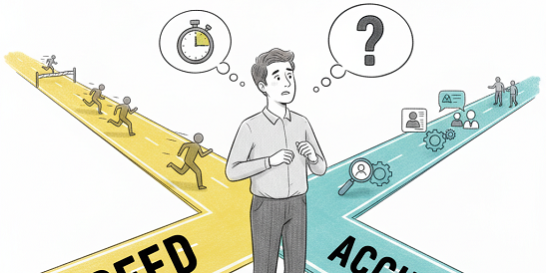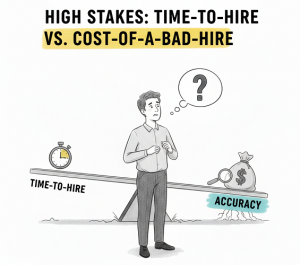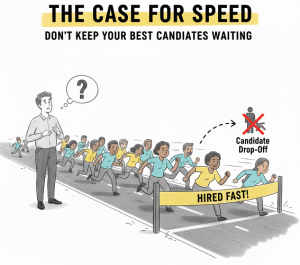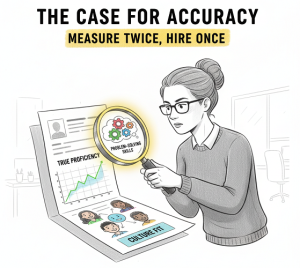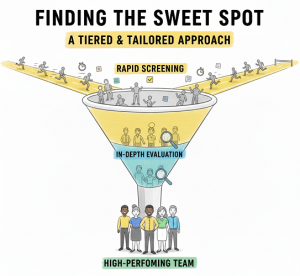Meet Mark. He’s a recruiter in a fast-growing tech company, and he’s under pressure. A critical sales role has been open for three weeks, and the hiring manager wants someone in the seat yesterday. The pipeline has two promising candidates. One has a polished CV and can be assessed quickly with a short online quiz. The other has a more unconventional background but seems to have deep industry knowledge that requires a more thorough, time-consuming evaluation.
What does Mark do? Does he choose the fast route to please the hiring manager, or does he push for the more in-depth assessment and risk losing the candidate in a competitive market?
Mark’s dilemma is one that HR professionals, recruiters, and CEOs face every day. In the race to hire, we are constantly caught between two competing forces: the need for speed and the demand for accuracy. Get it wrong, and you either lose top talent to a faster competitor or make a costly hiring mistake. But get it right, and you’ve built the foundation for a high-performing team.
The high stakes: time-to-hire vs. cost-of-a-bad-hire
In recruitment, we live by our metrics. Time-to-Hire is a critical KPI, and in a market where top candidates are off the table in just 10 days, speed is undeniably a competitive advantage. A slow, cumbersome process leads to high candidate drop-off rates and missed opportunities.
However, moving too fast has its own perils. The flip side of the coin is the staggering Cost-of-a-Bad-Hire. Research from the U.S. Department of Labor suggests a bad hire can cost a company up to 30% of the employee’s first-year earnings. This doesn’t just account for salary, but also for the costs of recruitment, onboarding, lost productivity, and the negative impact on team morale.
The real challenge isn’t choosing one over the other. It’s about building a process that is both efficient and effective.
The case for speed: don’t keep your best candidates waiting
Let’s be clear: a rapid assessment process is essential in today’s talent landscape. Its benefits include:
- Improved candidate experience: a swift, responsive process shows that you value the candidate’s time and are serious about hiring.
- Reduced drop-off: the longer your process takes, the more likely your top candidates will accept an offer elsewhere.
- Scalability: for high-volume roles, rapid screening tools are the only way to manage a large applicant pool efficiently.
Quick online quizzes, automated screeners, and brief initial evaluations are excellent tools for the top of the hiring funnel, helping you quickly filter a large number of applicants down to a manageable shortlist.
The case for accuracy: measure twice, hire once
While speed gets candidates in the door, accuracy ensures the right ones stay. An in-depth evaluation goes beyond surface-level skills to uncover the nuances that define a great employee.
This is where you discover:
- True proficiency: does the candidate truly possess the deep skills needed for the role, or do they just know the right buzzwords for their CV?
- Problem-solving skills: how do they handle real-world challenges specific to your business?
- Culture fit: will they collaborate well with the existing team and thrive in your company’s environment?
Comprehensive skill audits, behavioural interviews, and practical case studies are your tools for achieving this level of certainty. They take more time, but the ROI in terms of long-term performance and retention is immeasurable. Remember Mark, our recruiter? A quick quiz might not reveal a candidate’s ability to navigate a complex negotiation, a crucial skill for his open sales role.
Finding the sweet spot: a tiered and tailored approach
So, how do you get the best of both worlds? It’s not about a one-size-fits-all solution. It’s about being strategic.
- Implement a tiered assessment strategy: don’t use a sledgehammer to crack a nut. Use rapid, automated assessments for initial screening to build your shortlist. Once you have your top 3-5 candidates, invest the time in more robust, in-depth evaluations. This way, you focus your most intensive efforts where they have the greatest impact.
- Tailor the process to the role: the right balance of speed and accuracy depends entirely on the position.
- High-volume, junior roles: the process can lean more towards speed and automation.
- Senior, specialized, or client-facing roles: accuracy is paramount. The risk associated with a bad hire in these positions is far too high to cut corners. More comprehensive, multi-stage assessments are non-negotiable.
- Leverage a smart assessment partner: the best assessment providers understand this balancing act. They offer a suite of tools, from quick screeners to deep-dive audits, allowing you to create a customized process that fits your exact needs.
Move fast, but hire smart
The debate between speed and accuracy is a false choice. A modern, effective hiring strategy doesn’t prioritize one over the other; it integrates them intelligently. By using rapid assessments to manage the top of your funnel and reserving in-depth evaluations for your finalists, you can create a process that is both fast enough to attract top talent and accurate enough to hire the right people.
You can close that critical role quickly, just as the hiring manager demands, but with the confidence that you’ve made a sound, data-driven decision that will benefit the company for years to come.
Struggling to find the right balance in your assessment process? We offer both rapid “short audits” for initial screening and comprehensive “full audits” for in-depth evaluation. Let’s talk about building a smarter, more effective language assessment strategy for your team.



